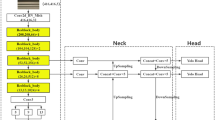Abstract
The surface defect detection of aluminum sheet is of great significance to ensure the appearance and quality of aluminum sheet. The surface defects of aluminum sheets have the characteristics of different shapes, obvious size differences, and difficult to obtain defect samples, which make defect detection challenging. In order to solve this problem, we make the following improvements to YOLOv3: Adding attention mechanism modules after the three feature layers output by the model backbone and after neck upsampling; Freezing the model backbone and using pretrained for transfer learning. The proposed YOLOv3 + ECA model is compared with the target detection models such as YOLOv3 and Faster-RCNN. It is found that the mAP of our model reaches 96.22%, which is higher than the current conventional algorithm. The AP values for different types of defects have good detection results.
Access this chapter
Tax calculation will be finalised at checkout
Purchases are for personal use only
Similar content being viewed by others
References
Zhang, J., Song, B., Wei, Q., et al.: A review of selective laser melting of aluminum alloys: processing, microstructure, property and developing trends. J. Mater. Sci. Technol. 35(2), 270–284 (2019)
Tao, X., Zhang, D., Ma, W., et al.: Automatic metallic surface defect detection and recognition with convolutional neural networks. Appl. Sci. 1575, 1–15 (2018)
Dehui, W., Lingxin, S., Wang, X., et al.: A novel non-destructive testing method by measuring the change rate of magnetic flux leakage. J. Nondestr. Eval. 36(2), 1–11 (2017)
Malarvel, M., Singh, H.: An autonomous technique for weld defects detection and classification using multi-class support vector machine in X-radiography image. Optik 231, 166342 (2021)
O’Mahony, N., et al.: Deep learning vs. traditional computer vision. In: Arai, K., Kapoor, S. (eds.) CVC 2019. AISC, vol. 943, pp. 128–144. Springer, Cham (2020). https://doi.org/10.1007/978-3-030-17795-9_10
Yang, J., Li, S., Wang, Z., Dong, H., Wang, J., Tang, S.: Using deep learning to detect defects in manufacturing: a comprehensive survey and current challenges. Materials 13(24), 5755 (2020)
Ren, S., He, K., Girshick, R., et al.: Faster R-CNN: towards real-time object detection with region proposal networks. IEEE Trans. Pattern Anal. Mach. Intell. 39(6), 1137–1149 (2017)
Ding, R., Dai, L., Li, G., et al.: TDD-net: a tiny defect detection network for printed circuit boards. CAAI Trans. Intell. Technol. 4(2), 110–116 (2019)
He, D., Wen, J., Lai, Z., et al.: Textile fabric defect detection based on improved faster R-CNN. AATCC J. Res/ 8(1_suppl), 82–90 (2021)
Guo, Z., Wang, C., Yang, G., et al.: MSFT-YOLO: improved YOLOv5 based on transformer for detecting defects of steel surface. Sensors 22(9), 3467 (2022)
Yao, Z., Wang, L.: ERBANet: enhancing region and boundary awareness for salient object detection. Neurocomputing 448, 152–167 (2021)
Li, Y.-L., Wang, S.: HAR-Net: Joint learning of hybrid attention for single-stage object detection. IEEE Transactions on Image Processing 29, 3092–3103 (2020)
Pan, S.J., Yang, Q.: A survey on transfer learning. IEEE Trans. Knowl. Data Eng. 22(10), 1345–1359 (2010)
Hu, R., Liu, Y., Gu, K., Min, X., Zhai, G.: Toward a no-reference quality metric for camera-captured images. IEEE Trans. Cybern. (2021)
Hu, R., Liu, Y., Wang, Z., et al.: Blind quality assessment of night-time image. Displays 69, 102045 (2021)
Funding
This work was supported by the Science and Technology Project of Jiangxi Provincial Department of Education under Grant no. GJJ200305 and GJJ191689, the Natural Science Foundation of Jiangxi Province under Grants no. 20202BABL202016.
Author information
Authors and Affiliations
Corresponding author
Editor information
Editors and Affiliations
Rights and permissions
Copyright information
© 2023 ICST Institute for Computer Sciences, Social Informatics and Telecommunications Engineering
About this paper
Cite this paper
Yang, L., Hu, G., Huang, L. (2023). Surface Defect Detection Algorithm of Aluminum Sheet Based on Improved Yolov3. In: Cao, Y., Shao, X. (eds) Mobile Networks and Management. MONAMI 2022. Lecture Notes of the Institute for Computer Sciences, Social Informatics and Telecommunications Engineering, vol 474. Springer, Cham. https://doi.org/10.1007/978-3-031-32443-7_9
Download citation
DOI: https://doi.org/10.1007/978-3-031-32443-7_9
Published:
Publisher Name: Springer, Cham
Print ISBN: 978-3-031-32442-0
Online ISBN: 978-3-031-32443-7
eBook Packages: Computer ScienceComputer Science (R0)




